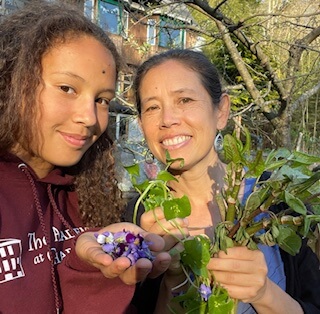Consider a spring dinner that starts with an appetizer of black locust flower fritters, followed by a dandelion and violet leaf salad sprinkled with violet flowers, pasta with garlic mustard pesto and boiled fiddleheads, wild leek and stinging nettle miso soup on the side, and a crisp of knotweed and wild blueberries for dessert. Creating meals like these have brought joy and inspiration to our family.
This year, we have been more involved in eating wild than ever. Over the winter, we spent many nights cracking black walnuts by the wood stove and feeling wonderment over nature’s delicious bounty. With the arrival of spring, we’ve been taking slow walks with sharp eyes peeled for delicious treats like spicy-sweet wild ramps, watching the blooming of dandelions, drooling over the ripening of wild strawberries, and talking with passion about how exciting it is to see every plant emerge from the earth. As my daughter completes a high school project compiling local wild food knowledge into a book of watercolor art and stories, the positive impact of foraging wild foods on our lifestyle and health, and the value of intergenerational and cross-species knowledge sharing, has become more and more apparent.
While wild foods may seem obscure, perhaps hearing about them sparks curiosity or reminds you of your own family traditions of gathering wild foods and relying on them in times of scarcity. With over 150 species of wild edible plants in New England, foraging wild food can be an ongoing practice, not just limited to times of scarcity. In all seasons, your meals can be enriched with flavors, nutrients, and stories from wild plants.
Many wild plants are nutritionally rich in many vitamins and minerals. For example, 100 grams (about 1.8 cups) of raw dandelion leaves provide 14% of daily calcium needs, 17% of daily iron needs, 39% of daily vitamin C needs, 56% of daily vitamin A needs, and 648% of daily vitamin K needs for an average healthy adult. When compared to an equal 100g weight of romaine lettuce (about 2 cups), dandelion leaves have 5.7 times the calcium, 3.2 times the iron, and 8.8 times the vitamin C content. Calcium is a highlight for other wild spring greens too: 100g of cooked stinging nettles (about 1 cup) provides 37% of daily calcium needs, and has 3.5 times the calcium in spinach; 100g of cooked lambsquarters (about ½ cup) provides 20% of daily calcium needs, and has 1.9 times the calcium in spinach.
The vitality and health that can be gained from foraging and eating wild plants is not limited to nutrients and feeding our physical bodies. The process of gathering wild flowers, leaves, roots, fruits, and nuts can also feed our spirit, increase our sense of connection, give us opportunity to reflect intentionally on how nature might impact us and teach us, and help us cultivate a better relationship with the land.
Many wild edible plants are ephemeral; there is usually a short window of time when their quality is ideal for eating. If you’ve ever picked a ripe wild berry, you probably remember the sweetness, happiness, and energy that eating something so fresh and natural can give you. Just as wild plants provide the right combination of nutrients to feed wild animals in different seasons, wild plants may also give us just what we need at a particular time, whether it’s bitter greens in early spring to support the liver’s processes, or nuts in the fall to give us healthy fats to sustain us for the long winter.
Foraging for wild food has been practiced for millenia, but the dependence on cultivated crops and the convenience of grocery stores has distanced many of us from knowledge and practice of foraging. Oak trees, which are abundant in the Northeast, offer plenty of acorns in the fall, but most people are daunted by the labor of filtering out the toxic astringent tannins in the nuts to make the nutritious flour for baking and cooking. We have grown away from harvesting and making our own food from scratch; but in the end, buying flour from a store will not reap the same nutritive or personal benefits of interacting with wild food.
The most common questions people ask when they hear about wild food foraging are: How do you know what to eat? How do you avoid getting poisoned?
It is important to approach foraging with safety and care for the environment at the forefront. Hands-on learning from experienced foragers and using reference books are essential for learning to identify plants at various stages of growth and distinguishing them from poisonous look-alikes. Mushrooms are notorious for the challenge in correctly identifying edible species. You should only eat mushrooms that you are 100% sure are edible; similarly, you should be cautious when foraging wild plants.
It is also crucial to pay attention to the environmental impact of harvesting from the wild. Is the plant threatened or endangered, or is it prolific? What is the lifecycle of the plant and how does harvesting impact its ability to regenerate? A good rule of thumb is to harvest no more than 20% from any particular spot, unless the plant is an invasive species, like garlic mustard or autumn olives, in which case harvesting can help manage the spread.
Also, consider the safety of the surroundings when foraging; stay clear of poison ivy and move carefully around thorny brush. Don’t harvest from polluted areas or places that have been sprayed with toxic chemicals.
If you are curious about foraging and interested in widening your taste palate, begin with commonly found and easily identifiable plants. Consider the following recipes (Forager Chef is a good source): garlic mustard pesto; stinging nettle soup; dandelion flower cookies; salads with dandelion, violet, chickweed, purslane, and jewelweed; stir fry with daylilies and lambsquarters; sumac lemonade; elderberry syrup; wild berries, rosehips, beach plums, and autumn olives fresh or made into smoothies, jams, pies, or fruit leather.
With curiosity and investigation, careful observation, and a conscientious mindset, wild food foraging can become an exciting addition to your outdoor adventures.
Table 1: Comparing the nutritional value of 100g of food using data from USDA FoodData Central: Raw dandelion leaves vs. raw romaine lettuce; cooked stinging nettle & lambsquarters vs. cooked spinach
| Raw Dandelion Leaves | Raw Romaine Lettuce | Cooked Stinging Nettle | Cooked Lambsquarters | Cooked Spinach | Daily Value Reference | |
|---|---|---|---|---|---|---|
| Calories | 45 kcal | 17 kcal | 42 kcal | 32 kcal | 23 kcal | 2000 kcal |
| Protein | 2.7 g | 1.23 g | 2.71 g | 3.2 g | 2.97 g | 50 g |
| Total Carbohydrates | 9.2 g | 3.3 g | 7.49 g | 5 g | 3.75 g | 275 g |
| Fiber | 3.5 g | 2.1 g | 6.9 g | 2.1 g | 2.4 g | 28 g |
| Calcium | 187 mg | 33 mg | 481 mg | 258 mg | 136 mg | 1300 mg |
| Iron | 3.1 mg | 0.97 mg | 1.64 mg | 0.7 mg | 3.57 mg | 18 mg |
| Sodium | 76 mg | 8 mg | 4 mg | 29 mg | 70 mg | 2300 mg |
| Magnesium | 36 mg | 14 mg | 57 mg | 23 mg | 87 mg | 420 mg |
| Potassium | 397 mg | 247 mg | 334 mg | 288 mg | 466 mg | 4700 mg |
| Vitamin C | 35 mg | 4 mg | No data | 37 mg | 9.8 mg | 90 mg |
| Vitamin A, RAE | 508 mcg | 436 mcg | 101 mcg | 391 mcg | 524 mcg | 900 mcg |
| Vitamin K | 778 mcg | 102 mcg | 449 mcg | 494 mcg | 494 mcg | 120 mcg |
| Folate, DFE | 27 mcg | 136 mcg | 14 mcg | 14 mcg | 146 mcg | 400 mcg |

Bi-sek Hsiao, PhD, MS, RD, LDN




